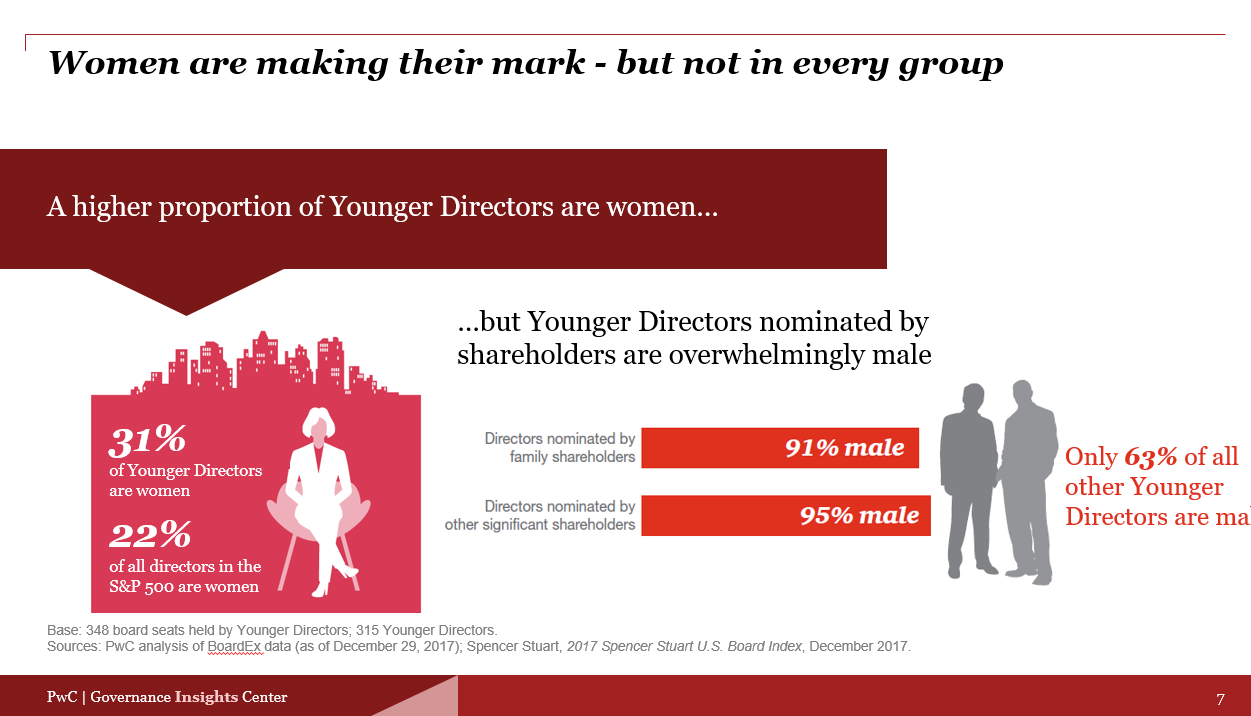According to PwC’s 2017 Annual Corporate Directors Survey, 90% of directors say that age diversity is important in fostering diversity of thought—a percentage that beat out both race and gender. Yet, you won’t find many younger directors in today’s boardrooms.

Of the 5,000+ board members who serve on S&P 500 boards, only 315 directors (6%) are 50 years old or younger. In an effort to dig a little deeper, PwC’s Governance Insights Center published a new report, Census of Directors 50 and Under, to explore the skills and composition of this demographic. The goal of this week’s webinar, hosted by PwC, Boardroom Resources, and Diligent, was to uncover the first-hand experiences of young directors and potential obstacles to recruiting and onboarding.
The panel was comprised of three young directors who currently sit on public company boards: Mike Steib, CEO of XO Group Inc. and director at Ally Financial, Margaret Whelan, CEO of Whelan Advisory, LLC and director at TopBuild, and Grady Summers, EVP and CTO of FireEye, Inc. and director at NETGEAR.

Moderated by PwC partner Catherine Bromilow and director Leah Malone, the panel discussion proved relevant to young, seasoned, and aspiring directors alike. We share a few highlights, along with the full-length webinar footage, below:
Youth can be isolating in today’s boardrooms. A good onboarding process is key.
According to the Spencer Stuart Board Index, the average age of an S&P 500 board member is 63 years old, roughly two decades older than this young director cohort.
“The biggest challenge I’ve found is not my gender, but my age,” explained Margaret Whelan. “These peers [on the board] are used to interacting with each other and maybe not with someone who’s younger. They don’t think about things the same way.”
Panelists described the social and logistical challenges of their age, often finding time for board responsibilities between the kids’ soccer practice and the demands of an executive-level day job. They shared positive aspects of their onboarding experience (e.g., being assigned an official mentor or “board buddy”), but also emphasized the responsibility of first-time directors to get themselves ‘board ready’.
First and foremost, the shareholders are not discounting their expectations of you to be a shepherd of their capital because you’re younger than the other directors. It’s your job to be a great director. So you have to do your homework…You have to make sure you get yourself educated on governance. I spent many days deep in the details on how the business was run and operated. Not [just] with the board and CEO, but with people in FP&A and line functions just to understand how it all works. So then when I came back up to the level of the board, I could be useful and knowledgeable.
— Mike Steib, Board Member, Ally Financial
As Grady Summers described, there’s definitely “good pressure to be extra prepared and prove yourself”.
“There’s certainly an argument that boards should be a little more cognizant of the background of the board member who might not understand: What’s the role of the board? What are the expectations, the constructs? How do committees work?,” said Summers. “The flipside is that anybody who’s given the opportunity to serve on a public board should be able to get up to speed and reach out to resources in their network…In my case, I did talk to other people I knew who served on boards. I read everything I could get my hands on about board governance and best practices.”
At a recent Next Gen Board Leaders Summit, a group of young directors described the multidimensional nature of a good onboarding process–one that includes training on the company, industry, board mechanics, and culture (among other aspects). The Next Gen Board Leaders community, started last summer by Spencer Stuart and Boardroom Resources, is designed to highlight the opportunities, challenges, and contributions of today’s board members; we encourage you to check out the website for additional guidance on onboarding.
Boards looking for a ‘young director’ are going to be disappointed.
The panelists cautioned against letting age drive a board’s search for candidates. If a board sets out to find a younger person, then it’s just going to get a younger person, said Steib, and not someone who fills out the capability set it really needs.
“My age, coming onto the board…was not an asset. And I don’t think it would have been a liability if I was 40 years older,” said Stieb. “Instead, in this case, the board felt that it needed someone who had particular expertise in consumer digital experiences and business model transformation…If you look at the sample of people who have [those skills]…it’s going to skew younger.”
You shouldn’t assume someone will be more effective because they’re younger or vice versa…By definition, a younger director just has less experience — less to draw on, less time in management, less time on other boards. We can’t stress that enough: you don’t want to add a younger director because they’re a younger director. [Rather,] it’s a side effect or something that happens when you’re looking for a particular skill set and when you find the right cultural fit…and they happen to be younger.
— Grady Summers, Board Member, NETGEAR
Panelists also described a tendency for some board members to assume that younger directors, given their age, have expertise in all aspects of technology or in emerging areas of oversight (e.g., sustainability), when in reality a digital marketing skill set is quite different from a cybersecurity background and vice versa.
They view board service as a valuable vehicle in their career development. It all comes down to choosing the right board.
Toward the end of the panel, moderator Catherine Bromilow asked: Given all you have to balance as young directors, is board service worth it?
“We are fortunate that…our board work does make us better executives and better business leaders for our day jobs,” said Summers speaking for the panel. “So I’ve never looked at it as something I have to hide from my CEO at FireEye. I’m fortunate to have leadership there that recognizes that this does make me a better executive.”
In order to get real value from board service, the panel stressed the importance of vetting the board with as much vigor as they’re vetting the candidates–and taking into consideration both culture fit and time constraints.
“The board service was important to me, but I only wanted to be on boards where I had relevant experience…” said Margaret, explaining that she was not willing to consider boards outside of her industry because of the added time commitment. “The boards that I’m on are in the industries I work in everyday, so that makes the strategy part of it easier to be on top of because it’s part of my day job.”
Whelan also described an aspect of personal fulfillment inherent in her board service.
I’m also on three nonprofit boards, locally in our community, around my children…I run the finance committees for all three, and I bring the committees into my home because I think it’s important for my children to see that–especially my girls.
— Margaret Whelan, Board Member, TopBuild
Highlights from the Census:










